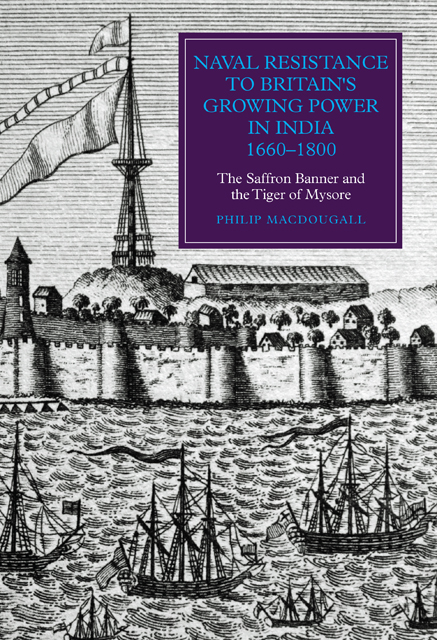 Naval Resistance to Britain's Growing Power in India, 1660–1800
Naval Resistance to Britain's Growing Power in India, 1660–1800 Published online by Cambridge University Press: 23 February 2023
In this city there reside many very wealthy Moorish merchants, and all the trade is in their hands. They have a fine mosque in the square of the town. The king is, as it were, governed by these Moors because of the presents which they give him; and owing to their industry the government is wholly in their hands, for these Christians are course people.
Girolamo Sernigi, c.1500
Towards the end of May 1498 Vasco da Gama hove to off Calicut having successfully confirmed in the most practical way possible that a sea route existed between Europe and the Indian sub-continent. The immediate objective was King Manuel I of Portugal (1495–1521) hoping to gain direct entry into the profitable spice trade that had previously been monopolised by Venetian merchants using the land route that connected the Mediterranean with the Red Sea. However Manuel I had a further object and one that extended beyond simple trade. He wished, with the support of the papacy, to eliminate the extensive influence of Muslims in the Indian Ocean, especially the trade networks established by Arab merchants with the port towns of India’s Malabar Coast. One of the most fervent of all Catholic countries, the rulers of Portugal were determined to bring about a total subjugation of Islam and to this end were already embroiled in a vicious war against Moorish forces in Morocco. Indeed, the decision to search out a sea route to India was nothing less than an extension of the earlier medieval crusades, allowing Portugal to strike a blow at both the Ottoman Empire and the Mamluk state of Egypt. Since the fall of Constantinople in 1453 the onward transshipment into Europe of spices traded on the Malabar Coast had to pass through these Muslim territories, bringing to both great financial benefit and helping ensure that they could maintain a continuing high level of expenditure on their military forces. That the Ottoman Turks were even, at that time, threatening to take the Holy City of Rome merely added to the urgency of the situation, pushing the Portuguese into the Indian Ocean to search out others who might embrace Christendom and join with them in this Holy Crusade.
To save this book to your Kindle, first ensure no-reply@cambridge.org is added to your Approved Personal Document E-mail List under your Personal Document Settings on the Manage Your Content and Devices page of your Amazon account. Then enter the ‘name’ part of your Kindle email address below. Find out more about saving to your Kindle.
Note you can select to save to either the @free.kindle.com or @kindle.com variations. ‘@free.kindle.com’ emails are free but can only be saved to your device when it is connected to wi-fi. ‘@kindle.com’ emails can be delivered even when you are not connected to wi-fi, but note that service fees apply.
Find out more about the Kindle Personal Document Service.
To save content items to your account, please confirm that you agree to abide by our usage policies. If this is the first time you use this feature, you will be asked to authorise Cambridge Core to connect with your account. Find out more about saving content to Dropbox.
To save content items to your account, please confirm that you agree to abide by our usage policies. If this is the first time you use this feature, you will be asked to authorise Cambridge Core to connect with your account. Find out more about saving content to Google Drive.